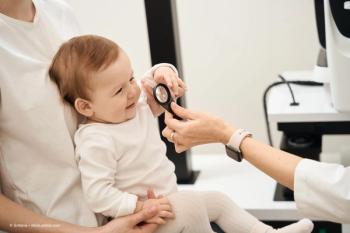
- Modern Retina Summer 2023
- Volume 3
- Issue 2
AI could increase health equity and boost adherence to annual eye examinations in patients with diabetes
How AI tools can drive early detection of diabetic eye conditions.
Reviewed by T. Y. Alvin Liu, MD; Ariel Leong, MS; and Jane Huang, BS
Led by T. Y. Alvin Liu, MD, a retinal specialist at the Johns Hopkins Wilmer Eye Institute and the director of the Wilmer Precision Ophthalmology Center of Excellence in Baltimore, Maryland, investigators focus on improving visual outcomes for patients with diabetes using autonomous artificial intelligence (AI). Ariel Leong, MS, and Jane Huang, BS, both second-year medical students at John Hopkins School of Medicine in Baltimore, Maryland presented studies at the 2023 Annual Meeting of the Association for Research in Vision and Ophthalmology, showing autonomous AI testing at primary care clinics was associated with increased health equity and patient adherence to annual eye examinations in populations at risk of diabetic eye disease.
The data underscore the need to educate patients and the public about the potential impact of diabetes: Diabetic eye disease is a significant and growing problem in the US, with the number of patients affected by it expected to rise to nearly one-third of adults by 2050.
Study 1: Focus on annual eye testing
Leong and her colleagues compared characteristics of patients referred to the Wilmer Eye Institute via the standard of care (SOC) vs autonomous AI (IDx-DR; Digital Diagnostics). IDx-DR uses autonomous AI to analyze retinal images and detect referable diabetic retinopathy at primary care clinics.
The researchers conducted a retrospective analysis of patients with diabetes who had been referred to the institute between August 2020 and September 2022. The study’s primary outcome was to determine whether the best-corrected visual acuity (BCVA) of patients was associated with the referral pathway.
Patient variables studied included race, BCVA of each eye at presentation, and insurance coverage. Systemic health variables included hypertension (HTN) and chronic kidney disease (CKD) status.
A total of 3745 patients (52.4% female; median age, 63.2 years) were included: 3352 in the SOC group (median age, 61.9 years; 51.8% female) and 393 (median age, 63.2 years; 57.3% female) in the AI group.
According to the investigators, “the AI group was more likely to be Black [64.9% vs 44.4%, P < .001), have higher rate of Medicare coverage [39.4% vs 30.9%, P < .001], and have a higher systemic disease burden: HTN [P = .001] and CKD [P = .017]. Both SOC and AI groups presented with good vision. The median BCVA of the better-seeing eye was logMAR 0.0 [Snellen 20/20] in the SOC group and logMAR 0.1 [Snellen 20/25] in the AI group. However, the referral group/pathway [SOC vs AI] was not associated with better- or worse-seeing eye BCVA.”
Leong and colleagues concluded that patients who underwent autonomous AI testing for diabetic eye disease and subsequently presented to Wilmer Eye Institute had a higher baseline risk for the condition based on both social determinants of health and systemic health states. However, the AI group still presented with excellent vision, and the referral pathway was not associated with presenting VA.
The implication is that autonomous AI likely facilitated evaluation before visual damage has occurred and could increase health equity for individuals who are at greater risk for poor visual outcomes at baseline.
“This is an exciting result that we hope to investigate further,” says Leong. “There are well-documented disparities in diabetic retinopathy screening and outcomes. AI-facilitated, earlier presentation to ophthalmic care could be instrumental in reducing these gaps.”
Study 2: Focus on annual eye examinations
Huang and colleagues pointed out that although current guidelines recommend that patients with diabetes undergo an annual eye examination for diabetic eye disease, the rate of adherence to that recommendation is low. Huang and colleagues conducted a retrospective cross-sectional analysis to determine whether AI examinations are associated with improved adherence to annual diabetic retinopathy testing in an integrated health care system, hypothesizing that such tests at primary care clinics would increase adherence rates.
The investigators analyzed a cohort of 22,264 patients managed at John Hopkins Medicine, an integrated health care system, that included over 30 primary care sites. The sites were categorized based on whether they had implemented autonomous AI examinations with IDx-DR technology (AI group) or not (non-AI group). Patient data collected included age, language spoken, sex, adjusted clinical group (ACG) value (higher value indicates greater overall morbidity), insurance type, hemoglobin A1C (HbA1c) value, and time since diagnosis of diabetes. The primary outcome measured was adherence to diabetic retinopathy testing in both groups.
Significantly higher adherence was found among patients in the AI group (64.0%) than the non-AI group (46.4%, P < .001). A higher percentage of women underwent annual examinations than men (52.4% vs 50.8%, P < .05). The mean age (59.8 vs 56.6 years, P < .001) and median ACG value (0.045 vs 0.035, P < .001) were higher in adherent patients, who also had a lower mean HbA1c value (7.1% vs 7.3%, P < .001).
In the logistic regression analysis, patient variables predictive of adherence to diabetic retinopathy testing included management at an AI site, having military health insurance, female sex, lower HbA1c value, and older age. Based on these findings, the authors concluded that higher adherence to the recommended guidelines was associated with the implementation of autonomous AI exams at primary care clinics.
Study results suggest that deployment of autonomous AI examinations at primary care clinics may increase traditionally low rates of patient adherence to annual testing guidelines for diabetic eye disease.
“Even though autonomous AI technology for diabetic retinopathy examinations has been available for a few years, we haven’t had a tangible measure of its impact until now,” Huang said at the review of the article. “We are excited that AI technology might improve access to annual eye examinations and help facilitate longitudinal care for patients with diabetes. We’re looking forward to conducting additional studies to further break down the impact of AI for marginalized populations and long-term
health outcomes.” •
T. Y. Alvin Liu, MD
E: tliu25@jhmi.edu
Liu is an assistant professor of ophthalmology at the Johns Hopkins University School of Medicine in Baltimore, Maryland. He has no financial interest to report with respect to this subject matter.
Ariel Leong, MS
E: aleong5@jhmi.edu
Leong is a second-year medical student at the Johns Hopkins University School of Medicine in Baltimore, Maryland. She has no financial interest to report with respect to this subject matter.
Jane Huang, BS
E: jhuan176@jhmi.edu
Huang is a second-year medical student at the Johns Hopkins University School of Medicine, Baltimore, Maryland. She has no financial interest in this subject matter.
Articles in this issue
over 2 years ago
Study finds significant variance across imaging modalitiesover 2 years ago
New VEGF trap for wet AMD takes aim at VEGF-C and VEGF-Dover 2 years ago
Is complement therapy the path forward for geographic atrophy?over 2 years ago
Experts detail innovative therapies for DME and neovascular AMDNewsletter
Keep your retina practice on the forefront—subscribe for expert analysis and emerging trends in retinal disease management.















































